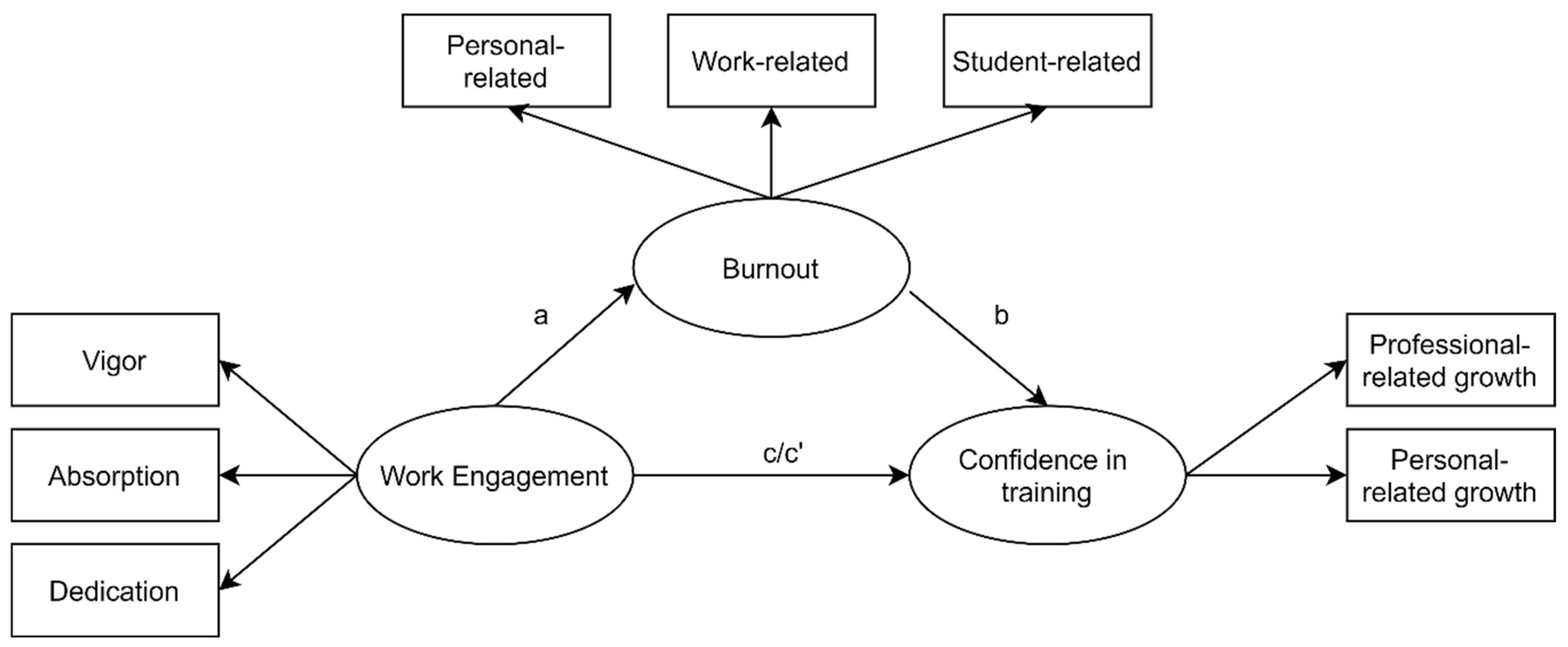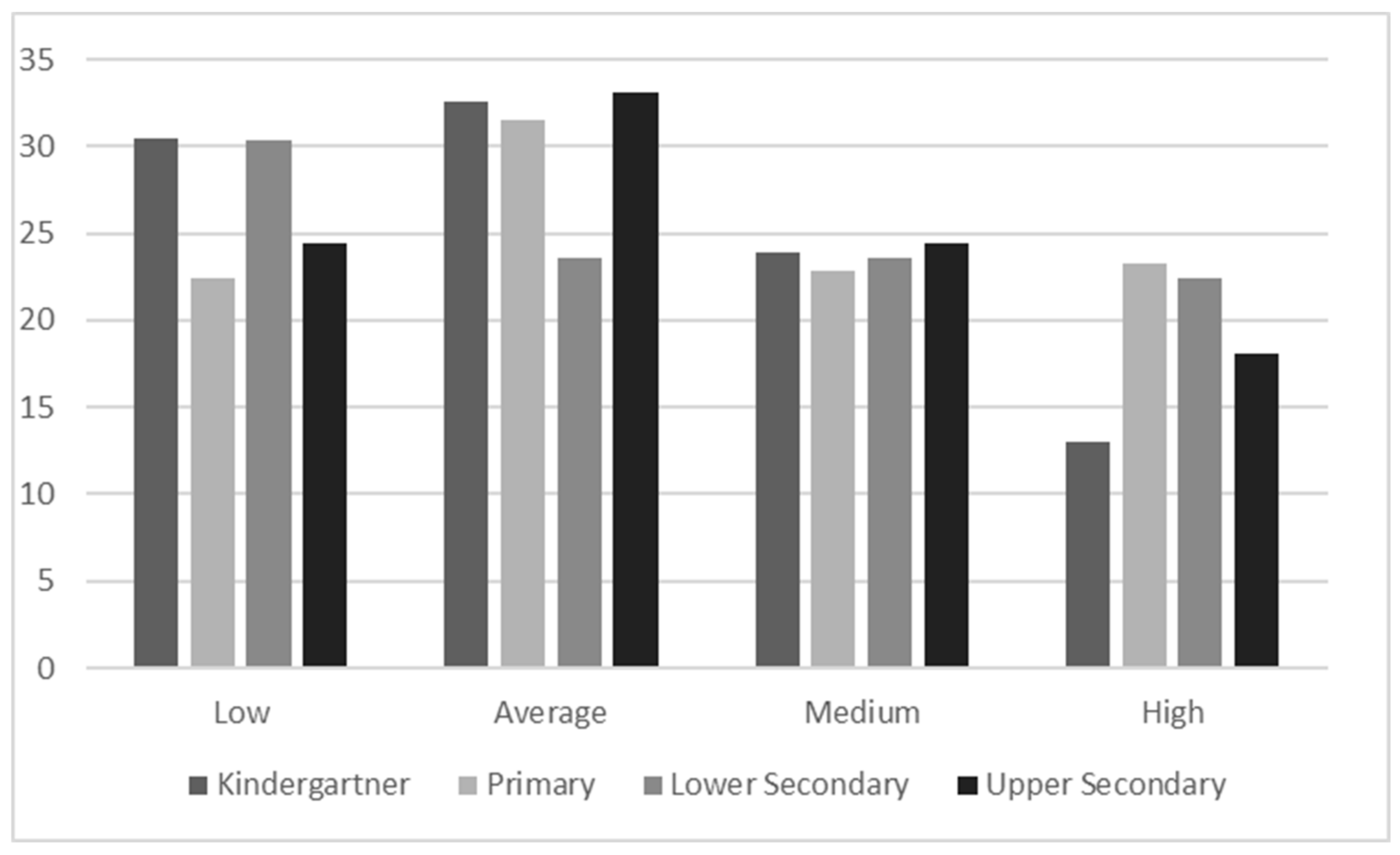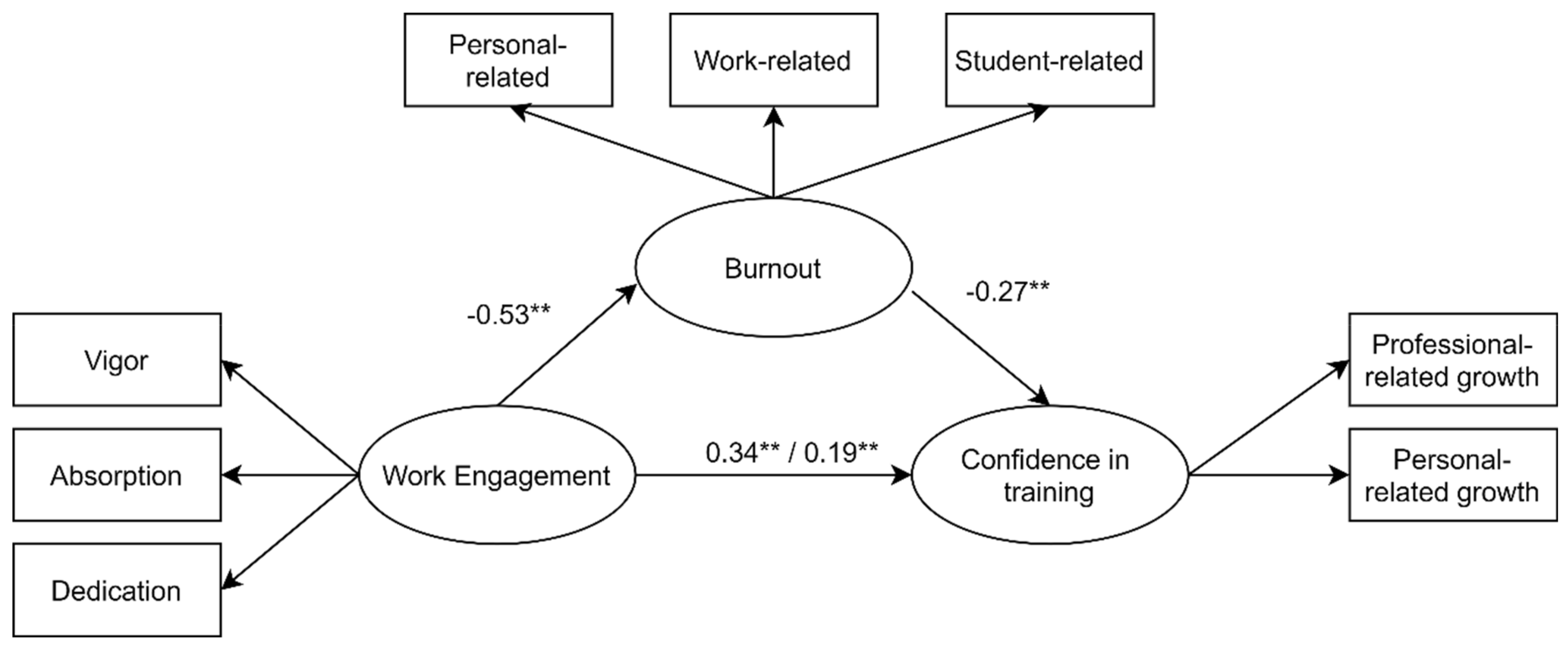Teacher Confidence in Professional Training: The Predictive Roles of Engagement and Burnout
Abstract
1. Introduction
2. Materials and Methods
2.1. Participants
2.2. Procedure
2.3. Measures
2.4. Strategy of Data Analyses
3. Results
3.1. Descriptive Statistics and Zero-Order Correlations among Teachers’ Engagement, Burnout, and Confidence in Training
3.2. Mediation Analysis Results
4. Discussion
Between Teachers’ Engagement and Confidence in Training: The Dramatic Impact of Burnout
5. Conclusions
Author Contributions
Funding
Conflicts of Interest
Appendix A
| 1. (En.) | they didn’t help me to change my attitudes and styles of teaching (reverse) |
| 1. (It.) | non hanno contribuito a cambiare le mie abitudini e stili di insegnamento |
| 2. (En.) | they made me feel less motivated about teaching (reverse) |
| 2. (It.) | hanno peggiorato la mia motivazione verso la scuola |
| 3. (En.) | they disappointed me because they fell short of my expectations (reverse) |
| 3. (It.) | mi hanno deluso perché al di sotto delle aspettative |
| 4. (Eng.) | they enabled me to discover new topics |
| 4. (It.) | mi hanno permesso di conoscere nuovi temi |
| 5. (En.) | they enabled me to try out new things in the classroom |
| 5. (It.) | mi hanno permesso di sperimentare nuove cose in aula |
| 6. (En.) | they increased my confidence in my own competencies |
| 6. (It.) | hanno aumentato la mia fiducia sulle mie competenze |
| 7. (En.) | they made me feel like giving up this job (reverse) |
| 7. (It.) | mi hanno fatto venir voglia di abbandonare il lavoro |
| 8. (En.) | I felt a sense of helplessness about all there is to be done at school (reverse) |
| 8. (It.) | ho provato una sensazione di impotenza rispetto a quanto c’è da fare a scuola |
| 9. (En.) | I thought that I would never attend such demanding courses again (reverse) |
| 9. (It.) | ho pensato che non avrei più seguito corsi così impegnativi |
| 10. (En.) | I found them too theoretical and distant from educational practice (reverse) |
| 10. (It.) | troppo teorici e distanti dalla pratica educativa |
| 11. (En.) | I found it difficult to apply the course contents with my students (reverse) |
| 11. (It.) | ho avuto difficoltà ad applicare con gli studenti ciò che ho ascoltato |
References
- Aliaga, A.O. Human capital, HRD and the knowledge organization. In Proceedings of the Academy of Human Resource Development 2001, Baton Rouge, LA, USA, 7 May 2001; pp. 427–434. [Google Scholar]
- Engelbrecht, H.-J. Human Capital and Economic Growth: Cross-Section Evidence for OECD Countries. Econ. Rec. 2003, 79, S40–S51. [Google Scholar] [CrossRef]
- Organisation for Economic Co-operation and Development Staff. OECD Creating Effective Teaching and Learning Environments: First Results from TALIS; OECD Publishing: Paris, France, 2009. [Google Scholar]
- Organisation for Economic Co-operation and Development Staff. OECD Factbook 2018: Economic, Environmental and Social Statistics; OECD Publishing: Paris, France, 2018. [Google Scholar]
- Darling-Hammond, L.; Youngs, P. Defining “Highly Qualified Teachers”: What Does “Scientifically-Based Research” Actually Tell Us? Educ. Res. 2002, 31, 13–25. [Google Scholar] [CrossRef]
- Massari, G.A. Key factors of preschool and primary school teachers job satisfaction. Ped. Acta 2015, 5, 27–40. [Google Scholar]
- Organisation for Economic Co-operation and Development Staff OECD Factbook 2005: Economic, Environmental and Social Statistics; OECD Publishing: Paris, France, 2005.
- Spear, M.; Gould, K.; Lee, B. Who Would be a Teacher?: A Review of Factors Motivating and Demotivating Prospective and Practising Teachers; NFER: Slough, UK, 2000; ISBN 0700530142. [Google Scholar]
- Fiorilli, C.; Farina, E.; Buonomo, I.; Costa, S.; Romano, L.; Larcan, R.; Petrides, K.V. Trait emotional intelligence and school burnout: The mediating role of resilience and academic anxiety in high-school. Int. J. Environ. Res. Public Health 2020, 17, 58. [Google Scholar] [CrossRef]
- Tschannen-Moran, M.; Hoy, A.W. Teacher efficacy: Capturing an elusive construct. Teach. Teach. Educ. 2001, 17, 783–805. [Google Scholar] [CrossRef]
- Maslach, C.; Jackson, S.E.; Leiter, M.P. Maslach Burnout Inventory manual, 3rd ed.; Consulting Psychologist Press: Palo Alto, CA, USA, 1996. [Google Scholar]
- Schaufeli, W.B.; Salanova, M.; González-Romá, V.; Bakker, A.B. The measurement of engagement and burnout: A two sample confirmatory factor analytic approach. J. Happiness Stud. 2002, 3, 71–92. [Google Scholar] [CrossRef]
- Schaufeli, W.B.; Bakker, A.B. Defining and measuring work engagement: Bringing clarity to the concept. In Work Engagement: A Handbook of Essential Theory and Research; Bakker, A.B., Leiter, M.P., Eds.; Psychology Press: New York, NY, USA, 2010. [Google Scholar]
- Albrecht, S. Handbook of Employee Engagement; Edward Elgar Publishing: Cheltenham, UK, 2010. [Google Scholar]
- Rodríguez-Muñoz, A.; Sanz-Vergel, A.I.; Demerouti, E.; Bakker, A.B. Engaged at work and happy at home: A spillover–crossover model. J. Happiness Stud. 2014, 15, 271–283. [Google Scholar] [CrossRef]
- Fredrickson, B.L. The role of positive emotions in positive psychology: The broaden-and-build theory of positive emotions. Am. Psychol. 2001, 56, 218–226. [Google Scholar] [CrossRef]
- Bakker, A.B.; Xanthopoulou, D. Creativity and charisma among female leaders: The role of resources and work engagement. Int. J. Hum. Resour. Manag. 2013, 24, 2760–2779. [Google Scholar] [CrossRef]
- Heinz, M. Why choose teaching? An international review of empirical studies exploring student teachers’ career motivations and levels of commitment to teaching. Educ. Res. Eval. 2015, 21, 258–297. [Google Scholar] [CrossRef]
- Bakker, A.B.; Schaufeli, W.B.; Sixma, H.J.; Bosveld, W.; van Dierendonck, D. Patient demands, lack of reciprocity, and burnout: A five-year longitudinal study among general practitioners. J. Organ. Behav. 2000, 21, 425–441. [Google Scholar] [CrossRef]
- Benevene, P.; Fiorilli, C. Burnout syndrome at school: A comparison study with lay and consecrated italian teachers. Mediterr. J. Soc. Sci. 2015, 6, 501–506. [Google Scholar] [CrossRef]
- Fiorilli, C.; de Stasio, S.; Benevene, P.; Fioredistella-Iezzi, D.; Pepe, A.; Albanese, O. Copenhagen Burnout Inventory (CBI): A validation study in an Italian teacher group. TPM Test. Psychom. Methodol. Appl. Psychol. 2015, 22, 537–551. [Google Scholar] [CrossRef]
- Maaranen, K.; Kynäslahti, H.; Byman, R.; Jyrhämä, R.; Sintonen, S. Teacher education matters: Finnish teacher educators’ concerns, beliefs, and values. Eur. J. Teach. Educ. 2019, 42, 211–227. [Google Scholar] [CrossRef]
- Maslach, C. Burnout: The Cost of Caring; Prentice-Hall: Englewood Cliffs, NJ, USA, 1982. [Google Scholar]
- Maslach, C.; Jackson, S.E. The measurement of experienced burnout. J. Organ. Behav. 1981, 2, 99–113. [Google Scholar] [CrossRef]
- Kristensen, T.S.; Borritz, M.; Villadsen, E.; Christensen, K.B. The Copenhagen Burnout Inventory: A new tool for the assessment of burnout. Work Stress 2005, 19, 192–207. [Google Scholar] [CrossRef]
- Carlsson, R.; Lindqvist, P.; Nordänger, U.K. Is teacher attrition a poor estimate of the value of teacher education? A Swedish case. Eur. J. Teach. Educ. 2019, 42, 243–257. [Google Scholar] [CrossRef]
- Fiorilli, C.; Pepe, A.; Buonomo, I.; Albanese, O. At-risk teachers: The association between burnout levels and emotional appraisal processes. Open Psychol. J. 2017, 10, 127–139. [Google Scholar] [CrossRef]
- Fiorilli, C.; Schneider, B.; Buonomo, I.; Romano, L. Family and nonfamily support in relation to burnout and work engagement among Italian teachers. Psychol. Sch. 2019, 56, 781–791. [Google Scholar] [CrossRef]
- Darling-Hammond, L.; Hyler, M.E.; Gardner, M. Effective Teacher Professional Development; Learning Policy Institute: Palo Alto, CA, USA, 2017. [Google Scholar]
- Avalos, B. Teacher professional development in Teaching and Teacher Education over ten years. Teach. Teach. Educ. 2011, 27, 10–20. [Google Scholar] [CrossRef]
- Gorozidis, G.; Papaioannou, A.G. Teachers’ motivation to participate in training and to implement innovations. Teach. Teach. Educ. 2014, 39, 1–11. [Google Scholar] [CrossRef]
- Schaufeli, W.B.; Bakker, A.B. UWES- Utrecht Work Engagement Scale: Test Manual; Department of Psychology, Utrecht University: Utrecht, The Netherlands, 2003. [Google Scholar]
- Pisanti, R.; Paplomatas, A.; Bertini, M. Misurare le dimensioni positive nel lavoro in sanità: Un contributo all’adattamento italiano della UWES-Utrecht Work Engagement Scale. [Measuring the positive dimensions among health care workers: A contribution to the Italian Validation of the UWES-Utrecht Work Engagement]. G. Ital. Med. Lav. Erg. 2008, 30, A111–A119. [Google Scholar]
- Kline, R. Exploratory and confirmatory factor analysis. In Applied Quantitative Analysis in Education and the Social Sciences; Petscher, Y., Schatschneider, C., Compton, D.L., Eds.; Routledge: New York, NY, USA, 2013; pp. 183–217. [Google Scholar]
- Veronese, G.; Pepe, A.; Dagdouke, J.; Addimando, L.; Yagi, S. Measuring well-being in Israel and Palestine: The subjective well-being assessment scale. Psychol. Rep. 2017, 120, 1160–1177. [Google Scholar] [CrossRef] [PubMed]
- Veronese, G.; Pepe, A. Psychometric Properties of the Subjective Wellbeing Assessment Scale—French Version (SWBAS-18F): A Study With Young Refugees and Internally Displaced People in Nigerien Refugee Camps. J. Psychoeduc. Assess. 2020. [Google Scholar] [CrossRef]
- Arbuckle, J.L. IBM® Amos TM 23 User’s Guide; Amos Development Corporation: Chicago, IL, USA, 2014. [Google Scholar]
- Tanaka, J.S. Multifaceted conceptions of fit in structural equation models. In Testing Structural Equation Models; Bollen, K.A., Scott-Long, J., Eds.; Sage Focus Editions: Newbury Park, CA, USA, 1993; Volume 154, pp. 10–39. [Google Scholar]
- Hu, L.; Bentler, P.M. Cutoff criteria for fit indexes in covariance structure analysis: Conventional criteria versus new alternatives. Struct. Equ. Model. Multidiscip. J. 1999, 6, 1–55. [Google Scholar] [CrossRef]
- Chen, F.; Curran, P.J.; Bollen, K.A.; Kirby, J.; Paxton, P. An Empirical Evaluation of the Use of Fixed Cutoff Points in. Sociol Methods Res. 2008, 36, 462–494. [Google Scholar] [CrossRef]
- Thakkar, J.J. Applications of SEM and FAQs. In Structural Equation Modelling. Studies in Systems, Decision and Control; Thakkar, J.J., Ed.; Springer: Singapore, 2020; pp. 101–112. [Google Scholar]
- Gath, E.G.; Hayes, K. Bounds for the largest Mahalanobis distance. Linear Algebra Appl. 2006, 419, 93–106. [Google Scholar] [CrossRef]
- Hakanen, J.J.; Bakker, A.B.; Schaufeli, W.B. Burnout and work engagement among teachers. J. Sch. Psychol. 2006, 43, 495–513. [Google Scholar] [CrossRef]
- Prieto, L.L.; Soria, M.S.; Martínez, I.M.; Schaufeli, W. Extension of the Job Demands-Resources model in the prediction of burnout and engagement among teachers over time. Psicothema 2008, 20, 354–360. [Google Scholar]
- Halbesleben, J.R.B.; Harvey, J.; Bolino, M.C. Too Engaged? A Conservation of Resources View of the Relationship Between Work Engagement and Work Interference With Family. J. Appl. Psychol. 2009, 94, 1452–1465. [Google Scholar] [CrossRef]
- Harter, J.K.; Schmidt, F.L.; Hayes, T.L. Business-unit-level relationship between employee satisfaction, employee engagement, and business outcomes: A meta-analysis. J. Appl. Psychol. 2002, 87, 268–279. [Google Scholar] [CrossRef] [PubMed]
- Hoxsey, D. Are happy employees healthy employees? Researching the effects of employee engagement on absenteeism. Can. Public Adm. 2010, 53, 551–571. [Google Scholar] [CrossRef] [PubMed]
- Benevene, P.; Ittan, M.M.; Cortini, M. Self-Esteem and Happiness as Predictors of School Teachers’ Health: The Mediating Role of Job Satisfaction. Front. Psychol. 2018, 9, 933. [Google Scholar] [CrossRef] [PubMed]
- Gagné, M.; Deci, E.L. Self-determination theory and work motivation. J. Organ. Behav. 2005, 26, 331–362. [Google Scholar] [CrossRef]
- Zimmermann, F.; Rösler, L.; Möller, J.; Köller, O. How learning conditions and Program structure predict burnout and satisfaction in teacher education. Eur. J. Teach. Educ. 2018, 41, 318–342. [Google Scholar] [CrossRef]
- Passiatore, Y.; Pirchio, S.; Carrus, G.; Maricchiolo, F.; Fiorilli, C.; Arcidiacono, F. Intercultural practices and inclusive education in Europe: Can migration be a resource for individual and societal development? Eur. J. Psychol. Educ. 2019, 34, 209–224. [Google Scholar] [CrossRef]
- Buonomo, I.; Fatigante, M.; Fiorilli, C. Teachers’ Burnout Profile: Risk and Protective Factors. Open Psychol. J. 2017, 10, 190–201. [Google Scholar] [CrossRef]
- Fiorilli, C.; Benevene, P.; de Stasio, S.; Buonomo, I.; Romano, L.; Pepe, A.; Addimando, L. Teachers’ Burnout: The Role of Trait Emotional Intelligence and Social Support. Front. Psychol. 2019, 10, 2743. [Google Scholar] [CrossRef]
- Buonomo, I.; Fiorilli, C.; Benevene, P. The impact of emotions and hedonic balance on teachers’ self-efficacy: Testing the bouncing back effect of positive emotions. Front. Psychol. 2019, 10, 1670. [Google Scholar] [CrossRef]
- Bakker, A.B.; Hakanen, J.J.; Demerouti, E.; Xanthopoulou, D. Job resources boost work engagement, particularly when job demands are high. J. Educ. Psychol. 2007, 99, 274–284. [Google Scholar] [CrossRef]
- Chambers, G.; Coles, J.; Roper, T. Seeing it from both sides: Reasons for withdrawing from one-year secondary postgraduate certificate in education courses. Teach. Dev. 2002, 6, 373–390. [Google Scholar] [CrossRef]
- Roness, D. Still motivated? The motivation for teaching during the second year in the profession. Teach. Teach. Educ. 2011, 27, 628–638. [Google Scholar] [CrossRef]
- Skaalvik, E.M.; Skaalvik, S. Satisfaction, burnout and self-efficacy among teachers: A challenge for school leaders. In Skoleledelse. Betingelser for læring og ledelse iskolen [Management in schools. Conditions for learning and management in school]; Andreassen, R., Irgens, E.J., Skaalvik, E.M., Eds.; Tapir Akademisk Forlag: Trondheim, Norway, 2008; pp. 141–152. [Google Scholar]
- Benevene, P.; de Stasio, S.; Fiorilli, C.; Buonomo, I.; Ragni, B.; Briegas, J.J.M.; Barni, D. Effect of teachers’ happiness on teachers’ health. The mediating role of happiness at work. Front. Psychol. 2019, 10, 2449. [Google Scholar] [CrossRef] [PubMed]
- Buonomo, I.; Fiorilli, C.; Benevene, P. Unravelling Teacher Job Satisfaction: The Contribution of Collective Efficacy and Emotions Towards Professional Role. Int. J. Environ. Res. Public Health 2020, 17, 736. [Google Scholar] [CrossRef] [PubMed]
- Howard, S.; Johnson, B. Resilient teachers: Resisting stress and burnout. Soc. Psychol. Educ. 2004, 7, 399–420. [Google Scholar] [CrossRef]
- Betoret, F.D. Stressors, self-efficacy, coping resources, and burnout among secondary school teachers in Spain. Educ. Psychol. 2006, 26, 519–539. [Google Scholar] [CrossRef]
- Wideen, M.; Mayer-Smith, J.; Moon, B. A critical analysis of the research on learning to teach: Making the case for an ecological perspective on inquiry. Rev. Educ. Res. 1998, 68, 130–178. [Google Scholar] [CrossRef]
- Ome, A.; Menendez, A.; Le, H.E. Improving teaching quality through training: Evidence from the Caucasus. Econ. Educ. Rev. 2017, 61, 1–8. [Google Scholar] [CrossRef]
- Korthagen, F. Inconvenient truths about teacher learning: Towards professional development 3.0. Teach. Teach. 2017, 23, 387–405. [Google Scholar] [CrossRef]
- Peterson, C.; Seligman, M.E.P. Values in Action (VIA): Classification of Strengths; Values In Action Institute: Philadelphia, PA, USA, 2000. [Google Scholar]
- Zwart, R.C.; Korthagen, F.A.J.; Attema-Noordewier, S. A strength-based approach to teacher professional development. Prof. Dev. Educ. 2015, 41, 579–596. [Google Scholar] [CrossRef]
- Hellström, T. Transferability and naturalistic generalization: New generalizability concepts for social science or old wine in new bottles? Qual. Quant. 2008, 42, 321–337. [Google Scholar] [CrossRef]
- Lindell, M.K.; Whitney, D.J. Accounting for common method variance in cross-sectional research designs. J. Appl. Psychol. 2001, 86, 114–121. [Google Scholar] [CrossRef] [PubMed]



| Vigor (%) | Dedication (%) | Absorption (%) | |
|---|---|---|---|
| Very low | 7.1 | 1.7 | 2.1 |
| Low | 8.7 | 5.2 | 4.8 |
| Average | 43.5 | 29.3 | 28.7 |
| High | 30.4 | 32.2 | 37.0 |
| Very high | 10.4 | 31.6 | 27.4 |
| 1 | 2 | 3 | 4 | 5 | 6 | 7 | |
|---|---|---|---|---|---|---|---|
| 1. Personal burnout | 1 | ||||||
| 2. Work-related burnout | 0.83 ** | 1 | |||||
| 3. Student-related burnout | 0.63 ** | 0.73 ** | 1 | ||||
| 4. Vigor | −0.46 ** | −0.52 | −0.51 ** | 1 | |||
| 5. Dedication | −0.42 ** | −0.48 ** | −0.52 ** | 0.83 ** | 1 | ||
| 6. Absorption | −0.24 ** | −0.30 ** | −0.34 ** | 0.81 ** | 0.78 ** | 1 | |
| 7. Confidence in Training | −0.34 ** | −0.38 ** | −0.39 ** | 0.36 ** | 0.36 ** | 0.26 ** | 1 |
© 2020 by the authors. Licensee MDPI, Basel, Switzerland. This article is an open access article distributed under the terms and conditions of the Creative Commons Attribution (CC BY) license (http://creativecommons.org/licenses/by/4.0/).
Share and Cite
Fiorilli, C.; Buonomo, I.; Romano, L.; Passiatore, Y.; Iezzi, D.F.; Santoro, P.E.; Benevene, P.; Pepe, A. Teacher Confidence in Professional Training: The Predictive Roles of Engagement and Burnout. Sustainability 2020, 12, 6345. https://doi.org/10.3390/su12166345
Fiorilli C, Buonomo I, Romano L, Passiatore Y, Iezzi DF, Santoro PE, Benevene P, Pepe A. Teacher Confidence in Professional Training: The Predictive Roles of Engagement and Burnout. Sustainability. 2020; 12(16):6345. https://doi.org/10.3390/su12166345
Chicago/Turabian StyleFiorilli, Caterina, Ilaria Buonomo, Luciano Romano, Ylenia Passiatore, Domenica Fioredistella Iezzi, Paolo Emilio Santoro, Paula Benevene, and Alessandro Pepe. 2020. "Teacher Confidence in Professional Training: The Predictive Roles of Engagement and Burnout" Sustainability 12, no. 16: 6345. https://doi.org/10.3390/su12166345
APA StyleFiorilli, C., Buonomo, I., Romano, L., Passiatore, Y., Iezzi, D. F., Santoro, P. E., Benevene, P., & Pepe, A. (2020). Teacher Confidence in Professional Training: The Predictive Roles of Engagement and Burnout. Sustainability, 12(16), 6345. https://doi.org/10.3390/su12166345









